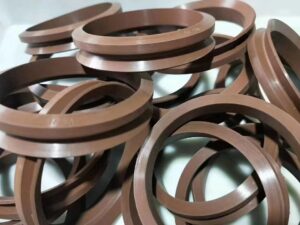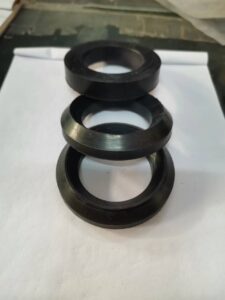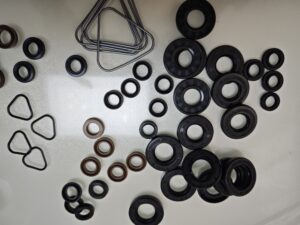Table of Contents
ToggleWhat Is an Oil Seal Ring?
An oil seal ring (also called a shaft seal, radial lip seal, or grease seal) is a precision-engineered mechanical device critical to machinery operation. It prevents lubricants like oil or grease from leaking out of rotating or reciprocating shafts while simultaneously blocking contaminants such as dirt, dust, and water from entering the system. By creating a dynamic barrier between moving components and stationary housings, oil seal rings ensure efficient lubrication, reduce wear, and prolong equipment lifespan. This article explores their design, functionality, types, materials, applications, and maintenance best practices.



Definition and Core Purpose
What Does an Oil Seal Ring Do?
Oil seal rings serve two primary functions:
- Retain Lubricants: They seal gaps between shafts and housings to keep oil, grease, or hydraulic fluids within the system. This ensures proper lubrication of bearings, gears, and other moving parts.
- Exclude Contaminants: They act as barriers against external debris, moisture, and chemicals that could damage internal components.
Without oil seals, machinery would suffer rapid wear, overheating, and premature failure due to lubricant loss or contamination.
Key Components and Design
A standard oil seal ring consists of the following elements:
| Component | Function |
| Main Lip | Elastomer or polymer lip that contacts the shaft, forming the primary seal. |
| Minor Lip | Secondary lip (optional) to trap contaminants and retain lubrication. |
| Garter Spring | Helical spring applying radial pressure to maintain lip contact with the shaft. |
| Metal Case | Rigid outer shell ensuring secure installation into the housing bore. |
| Sealing Edge | Tapered edge on the lip for high-speed sealing efficiency. |
| OD Surface | Outer diameter surface that seals against the housing to prevent leaks. |
Design Variations:
- Single-Lip vs. Double-Lip: Single-lip seals focus on fluid retention, while double-lip designs add contaminant protection.
- Spring-Loaded: Incorporates a garter spring to compensate for lip wear.
- Cassette Seals: Multi-layered seals in a cartridge format for extreme environments.

How Oil Seal Rings Work
Oil seal rings operate through a combination of mechanical and material engineering:
- Dynamic Sealing: The elastomer lip maintains constant contact with the rotating shaft, adapting to minor misalignments and vibrations.
- Spring Assistance: The garter spring ensures consistent radial force, even as the lip wears over time.
- Contaminant Exclusion: Secondary lips or dust shields block external particles from bypassing the seal.
Critical Functions:
- Prevent lubricant leakage in engines, gearboxes, and pumps.
- Reduce friction and heat generation via self-lubricating materials.
- Protect against abrasive particles in harsh environments (e.g., mining, agriculture).
- Maintain pressure in hydraulic and pneumatic systems.
Materials and Compatibility
Material selection depends on operating conditions, fluid compatibility, and temperature ranges:
| Material | Properties | Applications |
| Nitrile (NBR) | Cost-effective; resistant to oils and fuels. | Automotive engines, transmissions. |
| Fluoroelastomer (FKM/Viton) | High heat/chemical resistance. | Aerospace, chemical processing. |
| Polyacrylate (ACM) | Excellent ozone and oxidation resistance. | Engine seals, industrial machinery. |
| Silicone (VMQ) | Wide temperature range (-60°C to 230°C); flexible. | Food processing, medical devices. |
| PTFE | Low friction; handles extreme temperatures and corrosive fluids. | High-speed pumps, chemical systems. |
Types of Oil Seal Rings
Oil seal rings are categorized by design and application:
- Radial Shaft Seals
- Most common type, featuring a metal case, elastomer lip, and spring.
- Used in motors, pumps, and automotive axles.
- Axial Shaft Seals
- Seal axial movement between components (e.g., gearbox covers).
- V-Rings (Axial Lip Seals)
- Single-piece, tapered seals for limited-space applications.
- Cassette Seals
- Multi-layered, heavy-duty seals for construction and mining equipment.
- Mechanical Face Seals
- Use rotating and stationary faces for high-pressure sealing in agricultural machinery.
Applications Across Industries
Oil seal rings are indispensable in:
- Automotive: Crankshafts, wheel hubs, transmissions.
- Industrial Machinery: Hydraulic pumps, electric motors, conveyor systems.
- Aerospace: Jet engine components requiring high-temperature resistance.
- Marine: Corrosion-resistant seals for propellers and stern tubes.
- Agriculture: Tractors, harvesters, and irrigation systems.
Installation and Maintenance Best Practices
Installation Guidelines:
- Clean shafts and housings thoroughly to remove debris.
- Lubricate the seal lip and shaft before installation.
- Use press tools to avoid damaging the sealing edge.
Maintenance Tips:
- Inspect seals regularly for cracks, hardening, or leaks.
- Replace seals immediately if wear exceeds manufacturer tolerances.
- Match seal materials to operational temperatures and chemical exposure.
Common Failure Causes
- Abrasive Wear: Caused by contaminated lubricants or rough shaft surfaces.
- Chemical Degradation: Incompatible fluids or solvents damaging the lip material.
- Thermal Stress: Excessive heat leading to lip hardening or cracking.
- Improper Installation: Misalignment or lip damage during assembly.
Conclusion
An oil seal ring is a vital component in virtually all mechanical systems, balancing durability, flexibility, and sealing performance. By understanding its design, material options, and maintenance requirements, engineers and technicians can optimize machinery reliability, reduce downtime, and extend operational lifespans. Whether in a car engine or a hydraulic excavator, oil seals remain the unsung heroes of mechanical efficiency.



Leave A Comment